Wheel Size: 29’’ (27.5’’ rear wheel compatible)
Suspension Travel:
- Frame: 120 mm
- Fork: 140 mm
Geometry Highlights:
- Sizes Offered: XS, S, M, L, XL
- Headtube Angle: 65.8° (Low), 66.3° (High)
- Reach (size Medium): 465 mm (Low), 470 mm (High)
- Chainstay Length (size Medium): 431 mm (Low), 429 mm (High)
- Frame Material: Carbon fiber
Price: Complete bikes starting at $5,999 USD (see below for build details)
Blister’s Measured Weight: 30.16 lbs / 13.68 kg (Pro XT/XTR Build, Size Large)
Reviewer: 6’, 165 lbs / 183 cm, 74.8 kg
Test Locations: Washington
Test Duration: 3 months
Wheel Size: 29’’ (27.5’’ rear wheel compatible)
Suspension Travel:
- Frame: 135 mm
- Fork: 150 mm
Geometry Highlights:
- Sizes Offered: XS, S, M, L, XL
- Headtube Angle: 65.3° (Low), 65.6° (High)
- Reach (size Medium): 460 mm (Low), 465 mm (High)
- Chainstay Length (size Medium): 431 mm (Low), 430 mm (High)
- Frame Material: Carbon fiber
Price: Complete bikes starting at $6,199 USD (see below for build details)
Blister’s Measured Weight: 30.81 lbs / 13.98 kg (Team XX Build, Size Large)
Reviewer: 6’, 165 lbs / 183 cm, 74.8 kg
Test Locations: Washington
Test Duration: 3 months
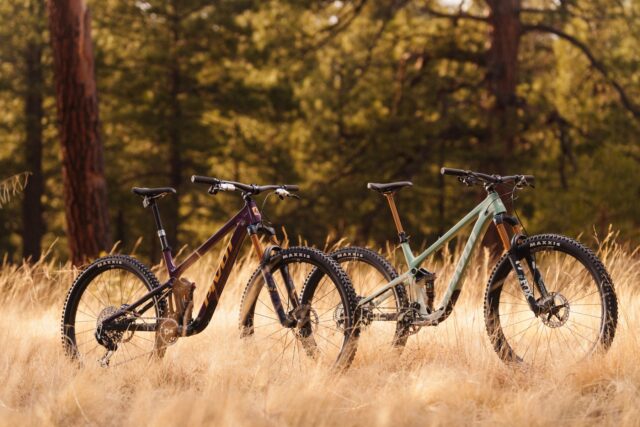
Intro
The Trail 429 platform hadn’t seen an update in a few years, and now it’s officially been put out to pasture. Instead of a refresh, Pivot went for more of a reinvention — and the new Trailcat SL and Trailcat LT are the result. With 120 mm of rear travel and 135 mm of rear travel, respectively, both Trailcat models share the same frame, but tackle different slices of the broad Trail bike segment.
We’ve spent time on — and been fans of — both the 27.5’’–wheeled Pivot Shadowcat and its 29’’ sibling, the Pivot Trail 429. Those two were a bit different in personality, largely down to the now–uncommon 27.5’’ wheel size on the Shadowcat lending an extra hint of playfulness and agility, but both were quite sporty and engaging on a wide variety of trails.
Do the new Trailcat SL and LT stick to the same playful persona of its predecessors? Let’s dig into what Pivot has come up with.
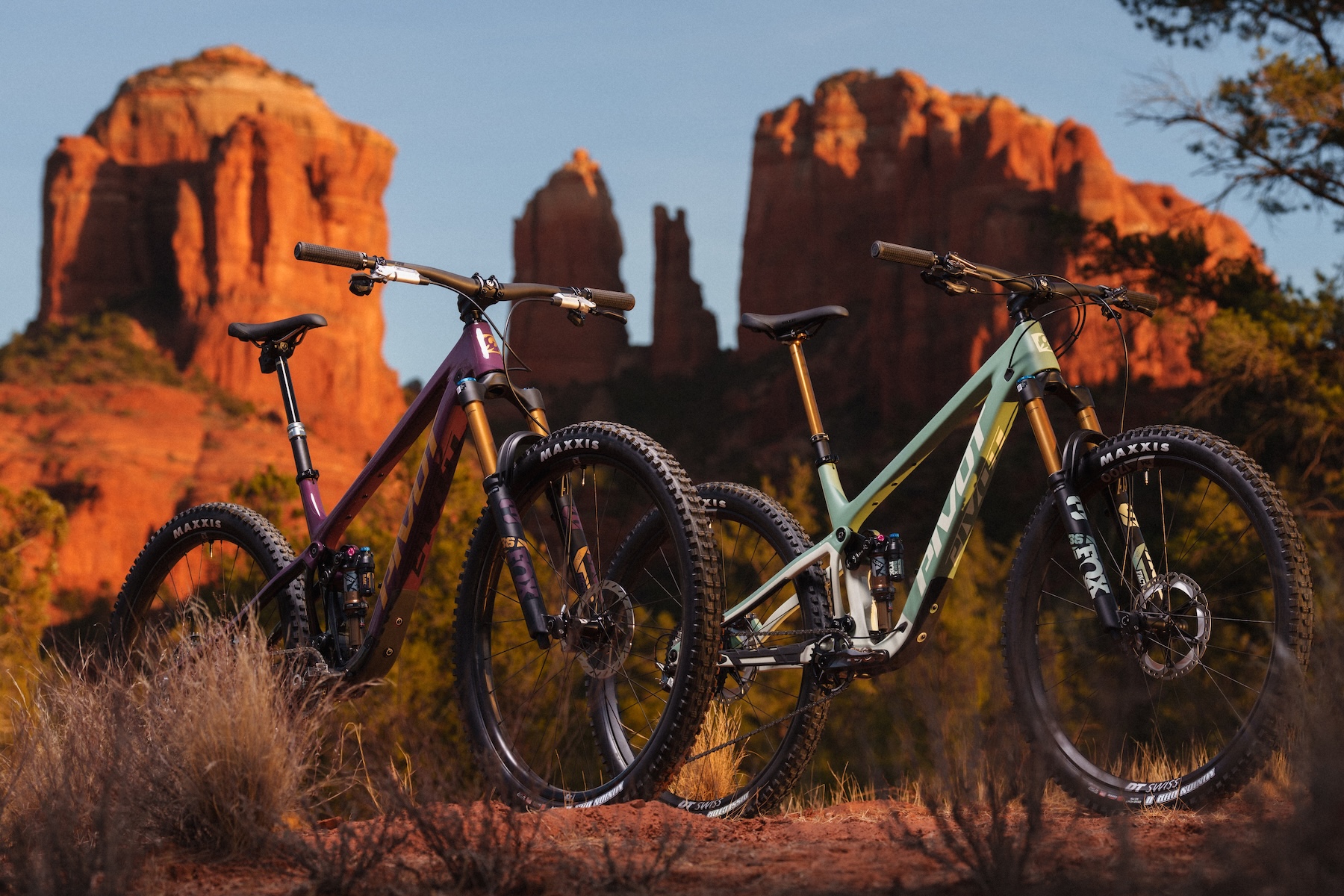
The Frame
Despite their differences in frame travel and geometry, the Trailcat SL and LT actually share the same exact frame, albeit with some tweaks. The front triangle, rear triangle, and lower link are the same; differences in the geometry and suspension numbers are down to different upper links being used, along with a flippable lower shock mount and different required shock lengths.
The Trailcat SL is the shorter travel option, with 120 mm of rear travel matched to a 140 mm travel fork. That shorter travel option uses a 165 mm eye-to-eye shock with a 45 mm stroke length. The longer-travel Trailcat LT bumps to 135 mm of rear travel and a 150 mm fork, with a 185 mm eye-to-eye, 55 mm stroke shock. Both still use Pivot’s familiar DW-Link suspension layout, which we’ve found to offer impressive pedaling efficiency in most implementations. While the Trailcat SL sits closer to Cross Country bikes in its travel, the Trailcat LT is still more middle-of-the-road rather than on the Enduro-adjacent side of the Trail spectrum. Its geometry backs up that conclusion, but more on that in a minute.
Outside of travel and geometry differences, all other features of the new Trailcat frame platform are common between the two models. First, Pivot has added in-frame storage that they call “Toolshed,” which uses a rotating aluminum latch to open the plastic door. The door itself has some nice touches, like an internal magnet that holds onto quick links for chain repairs, a strap loop, and two storage bags.
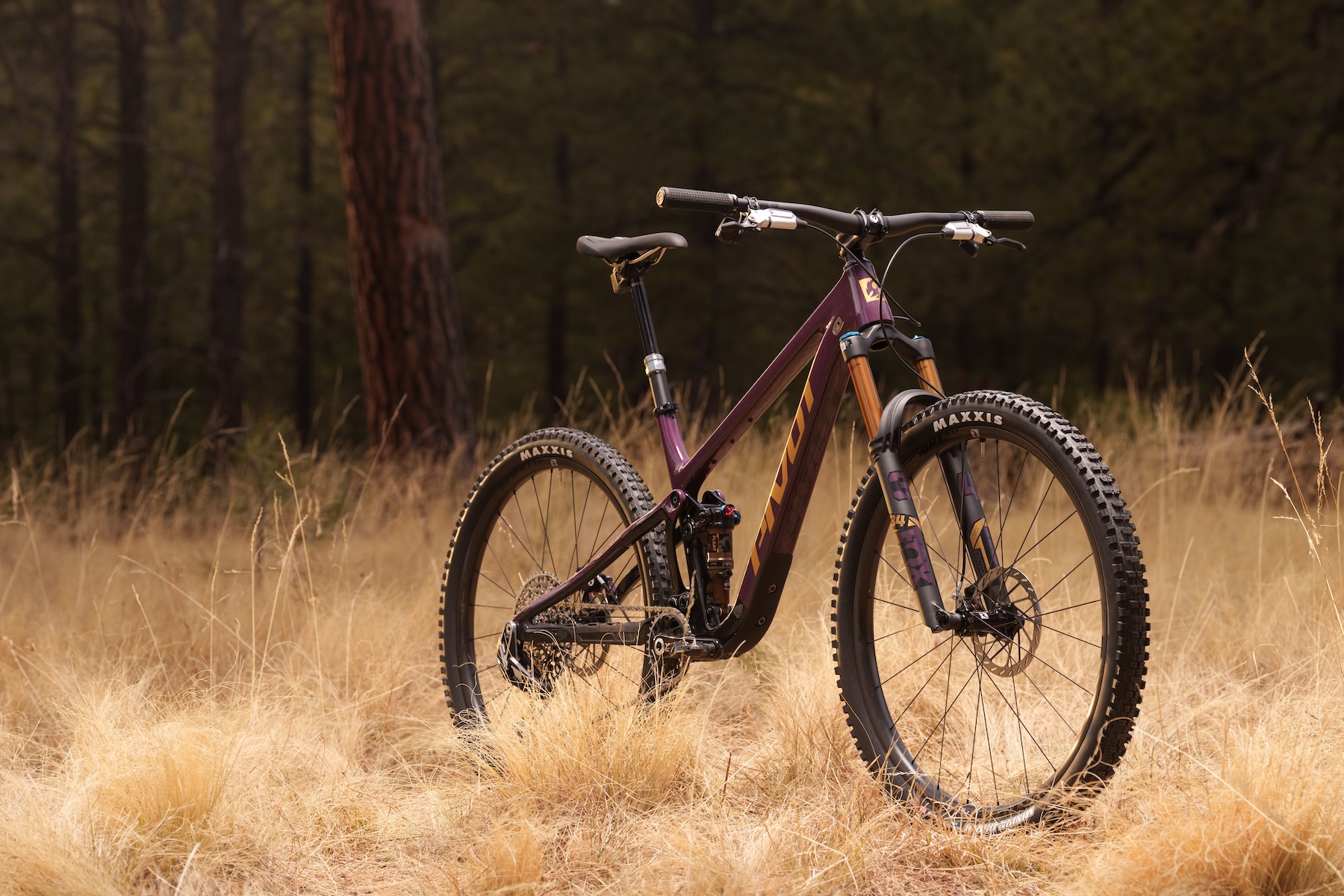
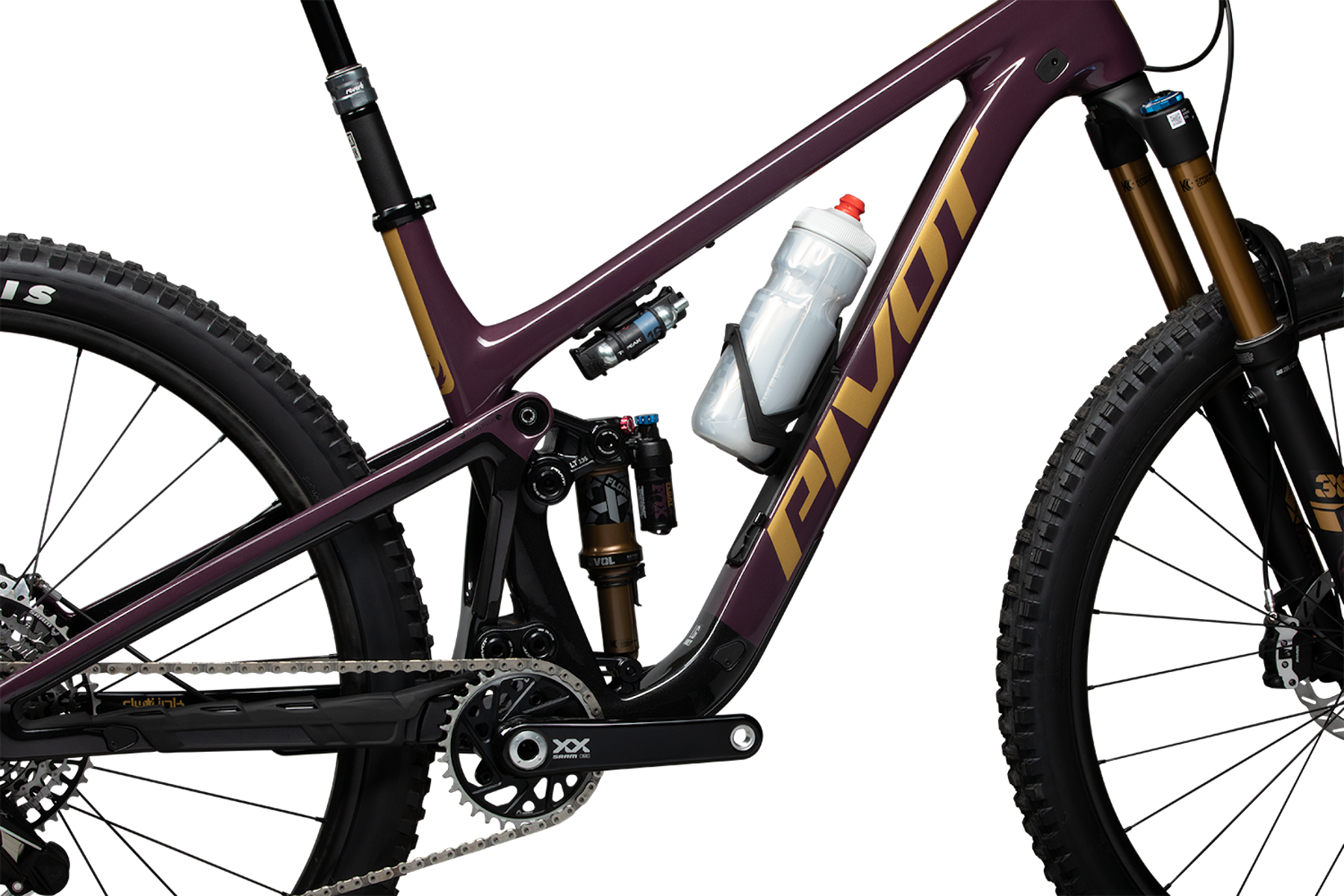
In addition to the internal storage, Pivot also offers their Dock Tool System collaboration with Topeak, which can be purchased separately and moves tool storage to the accessory mounts under the top tube.
Pivot’s notably easy-to-use flip chip design has made its way to the Trailcat too, positioned at the pivot point between the rear triangle and upper rocker link. Captive hardware means that there’s nothing to drop when making adjustments between the High and Low settings. While the Trailcat SL and LT both come set up with 29’’ wheels across sizes, Pivot says that both will accommodate a 27.5’’ rear wheel if the owner so desires, provided that the High flip chip position is used.
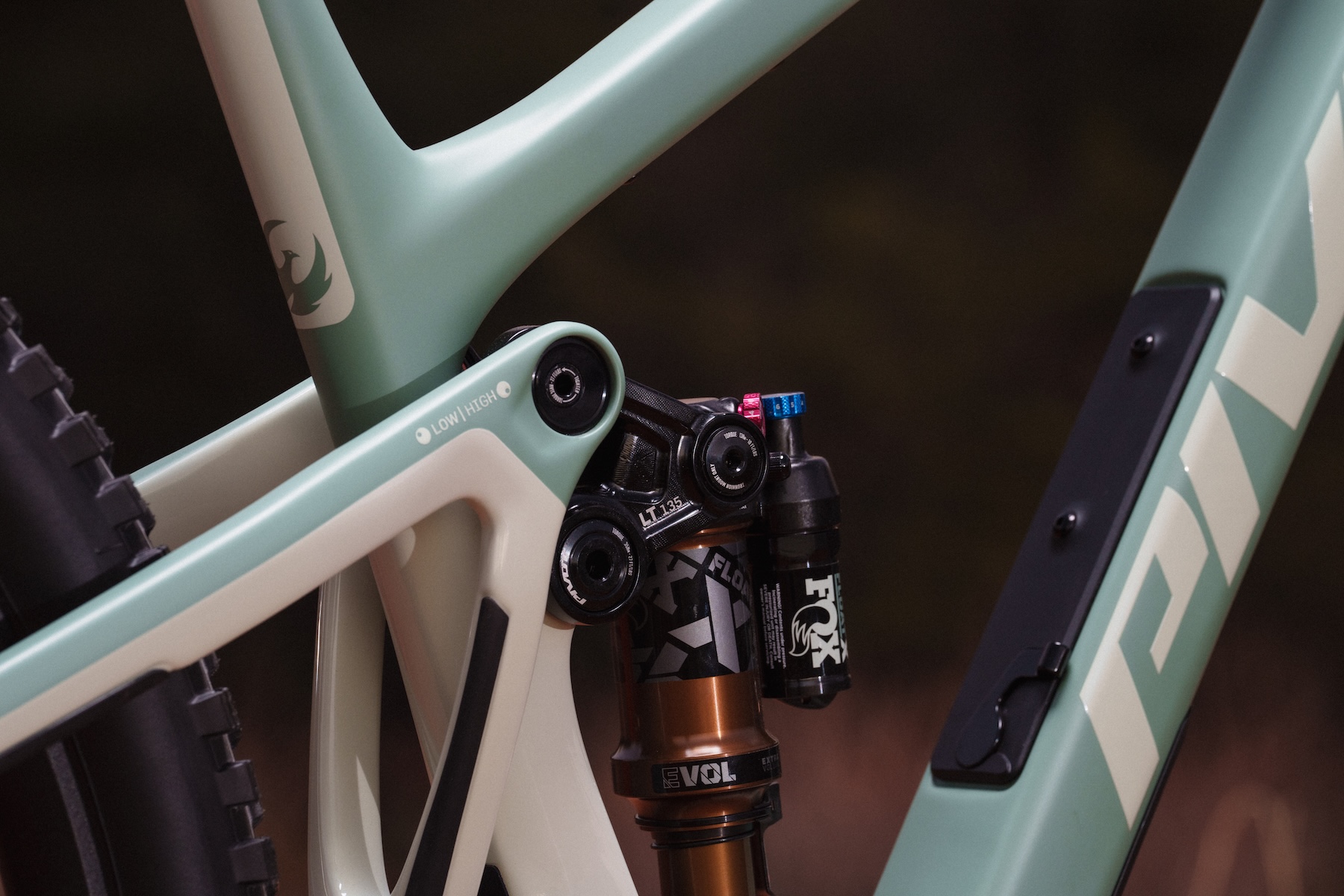
Other details include a new cable port design that allows two hoses to be routed through the same port, making routing a bit easier thanks to larger openings. There are also internal cable clips attached to the Toolshed insert in the downtube to prevent rattling. Offered only in carbon fiber, Pivot also says that the Trailcat frames have slightly different carbon layups in each size to tune stiffness to different average rider weights.
On a final note, Pivot continues with their Super Boost rear hub spacing, which means a 157 mm hub width is required. Pivot is one of only a few manufacturers still using that standard, which makes sourcing rear wheels a bit more challenging than with the more ubiquitous 148 mm Boost standard.
Fit & Geometry
Both models of the Trailcat are available in five sizes, ranging from XS to XL. As mentioned above, the different upper links, shock lengths, and shock mount positions that allow for the 15 mm travel variance between the SL and LT also lead to some differences in geometry between the two models. We’ll walk through the geometry numbers for each model below:
Trailcat SL
Unsurprisingly, the shorter-travel Trailcat SL gets slightly pointier geometry than the longer-travel LT. Starting in the Low setting, the Trailcat SL gets a 65.8° headtube angle, mated to a not-too-steep 76° (size Medium) that should allow for a comfortable pedaling position for covering miles on the flatter trails that the Trailcat SL will likely be used on. Reach on a size Medium is 465 mm, with a 625 mm stack and roomy 629 mm effective top tube length. Chainstay length does vary across sizes, but only slightly — the XS–Medium sizes all sit at 431 mm, while the Large moves to 432 mm, and the XL measures at 434 mm.
The flip chip varies the headtube angle by a modest 0.5°, along with minor tweaks to just about every other geometry figure. The headtube angle rises to 66.3°, the seat tube angle steepens to 76.4° on the size Medium, and the Medium’s reach grows to 470 mm too. The size Medium’s stack also shrinks slightly to 621 mm, and chainstay lengths fall by 2 mm for each size, dropping to 429 mm for XS through Medium.
Overall, those numbers seem on-point for a short-travel Trail bike, even if it’s not quite as slack as some other options hitting the market. The reach lengths are approximately average, but the top tube lengths in particular are rather stretched out. Mated to the rather short chainstays, that could mean that the Trailcat SL prefers a more forward riding position, but we’ll have to ride it and see.
The full geometry chart is as follows:
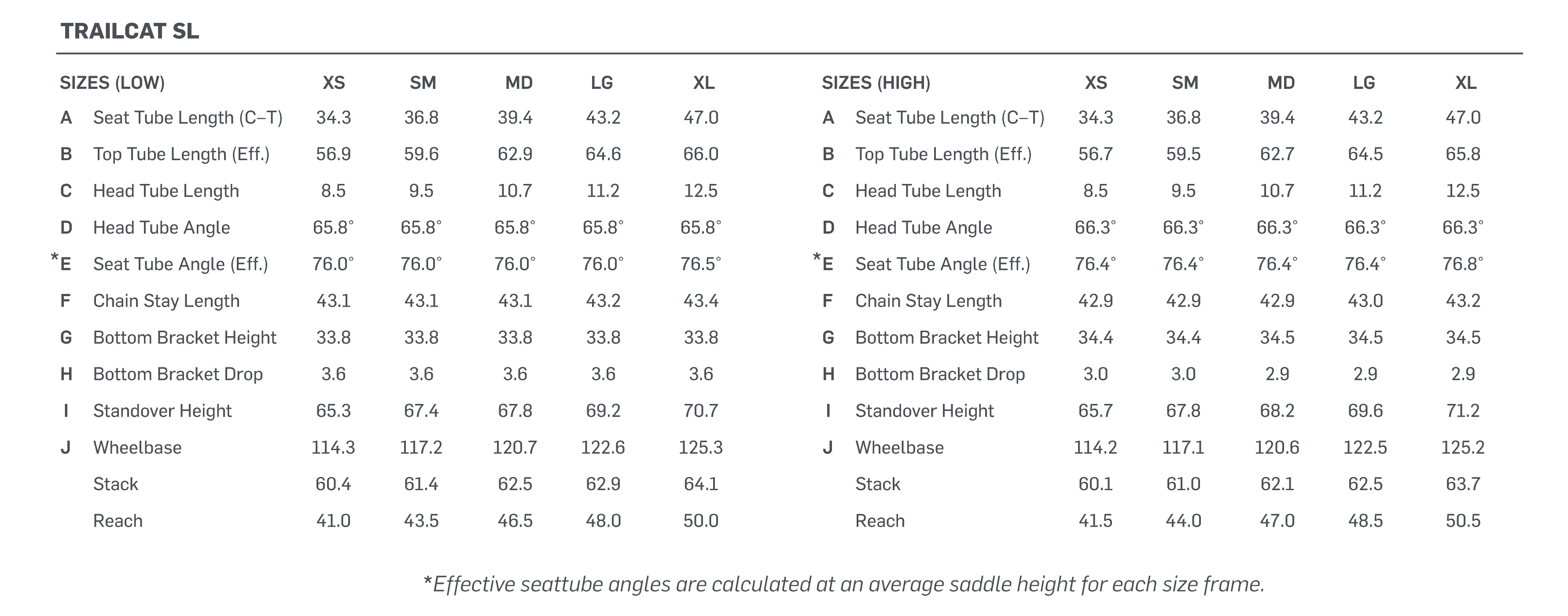
Trailcat LT
The Trailcat LT sees slightly slacker geometry in some respects, which is expected, but also doesn’t stray too far from the SL model’s numbers. In Low, the LT gets a 65.3° head tube angle and a slightly slacker-than-average 75.6° seat tube angle for a size Medium. The reach is 460 mm, the stack is 629 mm, and the effective top tube is still quite long at 631 mm. Chainstays again vary, with the XS–Medium sizes measuring 431 mm, and the Large and XL measuring 433 mm and 435 mm, respectively.
The flip chip has a smaller 0.3° influence on the head tube angle with the Trailcat LT, with the High setting creating a 65.6° head tube angle matched to a 76° seat tube angle. Reach and stack both shrink to 465 mm and 625 mm for a Medium, respectively, and the chainstays tighten up very slightly by 1-2 mm depending on the size.
If anything, the Trailcat LT seems a bit more conservative than expected in some respects for a bike sporting 135 mm of rear travel and 150 mm up front. For some folks, that may be highly appealing, but based on numbers alone that may suggest that the Trailcat LT feels more sharp handling and precise, rather than more planted and stable like some other mid-travel Trail bikes have become.
The full geometry chart is as follows:
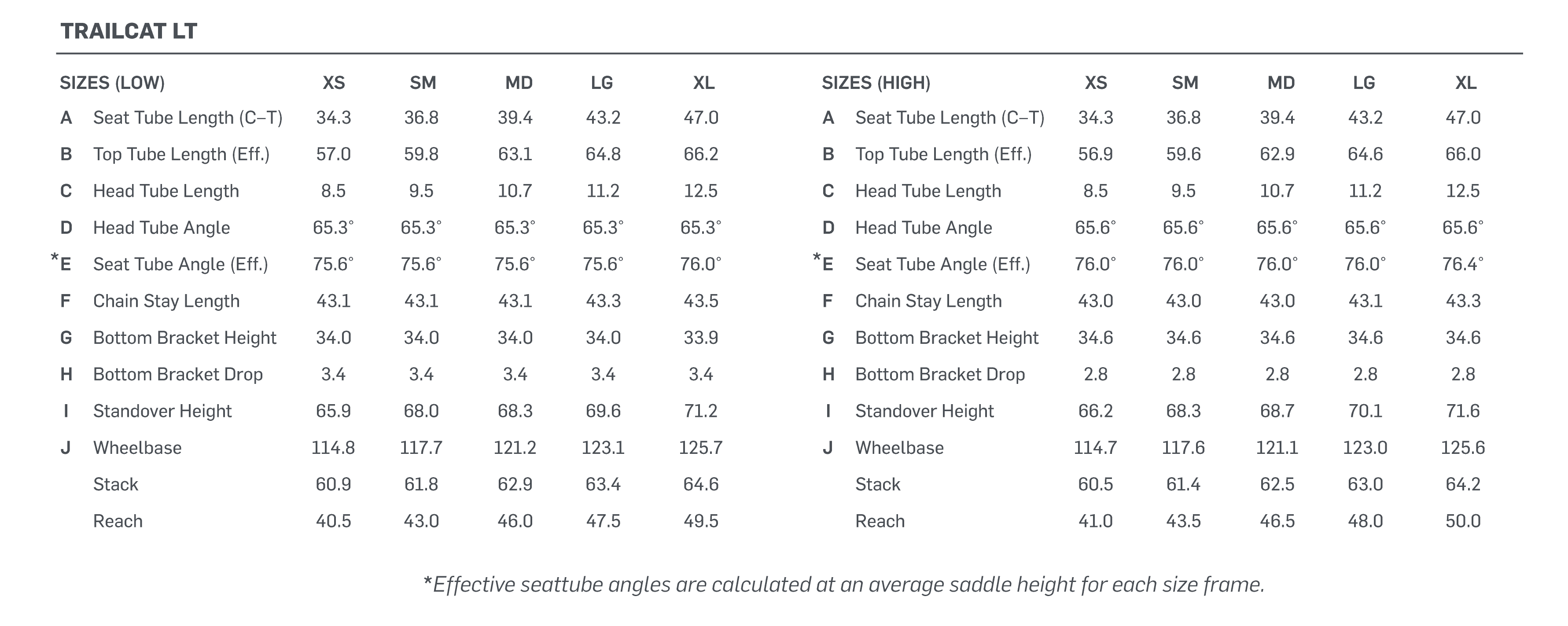
The Builds
Trailcat SL
Pivot has generally offered an impressively broad range of builds, and that continues here — though I would not say that the associated price tags will appeal to value-minded shoppers.
The base model build, the Ride SLX/XT, starts at $5,999 USD and gets a mix of SLX and XT drivetrain parts from Shimano, SLX 4-piston brakes, DT Swiss M1900 wheels, and Fox Performance-level suspension in the form of a 34 Grip fork and Float rear shock. There is also a Ride GX Eagle Transmission build that adds $800 in cost but moves to GX Eagle Transmission electronic shifting and SRAM DB8 brakes. The same Shimano and SRAM duality continues for the Pro tier of builds, which get Fox 34 Factory Grip X2 forks and Float Factory shocks, the choice of an XT/XTR drivetrain or XO Eagle Transmission, and upgraded brakes and wheels. The Pro level builds stick with DT Swiss wheels (the XM1700, specifically) but offer an upgrade option to the Reynolds Blacklabel 309/289 XC. Team-level builds keep the Fox Factory suspension but get nicer drivetrains and come stock with those Reynolds Blacklabel 309/289 wheels, while also getting incremental upgrades in some finishing components. Maxxis tires are used across all builds, though oddly with a DHR II EXO+ front tire and a lighter-duty EXO casing on the Dissector rear tire.
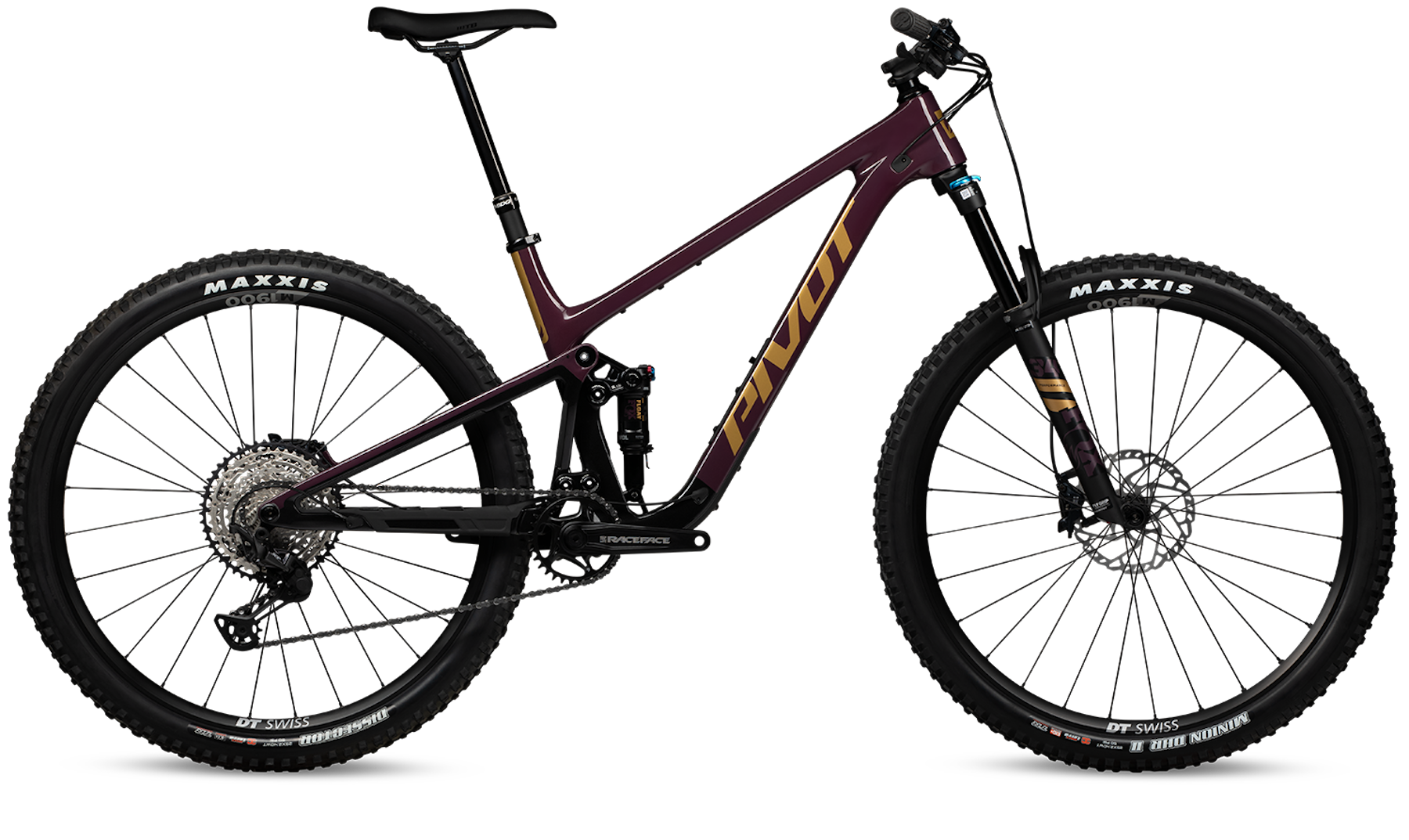
Remarkably, Pivot has opted to put SRAM Mavens on both the Pro XO Eagle Transmission and Team XX Eagle Transmission builds, making the Trailcat SL the lightest-duty bike I’ve seen to come with the brutally powerful Maven brakes. Those big stoppers are mated to 180 mm rotors, too, which I speculate could be overkill for many riders looking for a lightweight Trail bike. I’m typically a big brake evangelist, but on a 120 mm rear travel bike with relatively conservative geometry, Codes feel like the more appropriate choice.
On a final note, folks keen on electronic suspension will be pleased to find Fox Live Valve Neo as an option on the Pro and Team level builds for both SRAM or Shimano-equipped options. Opting for the Neo build kit gets you Fox’s Factory Float X Neo Live Valve shock and Transfer Neo seatpost, but it will cost buyers a pretty penny — an extra $2,000 USD over the non-Neo builds, to be exact. That brings the range-topping Team XX Eagle Transmission Neo build to an eye-popping $13,099 asking price.
The full set of builds is below:
- Drivetrain: Shimano SLX M7100 / XT M8100
- Brakes: Shimano SLX M7120 4-piston (180 mm rotors)
- Fork: Fox 34 Performance Grip (140 mm)
- Shock: Fox Float Performance
- Wheels: DT Swiss M1900
- Dropper Post: SDG Tellis (XS: 105-125 mm, S: 130-150, M: 150-170 mm), E13 Vario (L–XL: 180-210 mm)
- Drivetrain: SRAM GX Eagle Transmission
- Brakes: SRAM DB8 4-piston (180 mm rotors)
- Fork: Fox 34 Performance Grip (140 mm)
- Shock: Fox Float Performance
- Wheels: DT Swiss M1900
- Dropper Post: SDG Tellis (XS: 105-125 mm, S: 130-150, M: 150-170 mm), E13 Vario (L–XL: 180-210 mm)
- Drivetrain: Shimano XT M8100 / XTR M9100
- Brakes: Shimano XT M8120 4-piston (180 mm rotors)
- Fork: Fox 34 Factory Grip X2 (140 mm)
- Shock: Fox Float Factory
- Wheels: DT Swiss XM1700
- Dropper Post: Fox Transfer Factory (XS: 95-120 mm, S: 125-150, M: 155-180 mm, L–XL: 185-210 mm)
Optional wheel upgrade to Reynolds Blacklabel 309/289 XC rims with Industry Nine Hydra hubs (+$1,200 USD)
Optional suspension upgrade to Fox Float X Live Valve Neo and Fox Transfer Neo seatpost (+$2,000)
- Drivetrain: SRAM XO Eagle Transmission
- Brakes: SRAM Maven Silver 4-piston (180 mm rotors)
- Fork: Fox 34 Factory Grip X2 (140 mm)
- Shock: Fox Float Factory
- Wheels: DT Swiss XM1700
- Dropper Post: Fox Transfer Factory (XS: 95-120 mm, S: 125-150, M: 155-180 mm, L–XL: 185-210 mm)
Optional wheel upgrade to Reynolds Blacklabel 309/289 XC rims with Industry Nine Hydra hubs (+$1,200 USD)
Optional suspension upgrade to Fox Float X Live Valve Neo and Fox Transfer Neo seatpost (+$2,000)
- Drivetrain: Shimano XTR M9100
- Brakes: Shimano XTR M9120 4-piston (180 mm rotors)
- Fork: Fox 34 Factory Grip X2 (140 mm)
- Shock: Fox Float Factory
- Wheels: Reynolds Blacklabel 309/289 XC rims w/ Industry Nine Hydra hubs
- Dropper Post: Fox Transfer Factory (XS: 95-120 mm, S: 125-150, M: 155-180 mm, L–XL: 185-210 mm)
Optional suspension upgrade to Fox Float X Live Valve Neo and Fox Transfer Neo seatpost (+$2,000)
- Drivetrain: SRAM XX Eagle Transmission
- Brakes: SRAM Maven Ultimate 4-piston (180 mm rotors)
- Fork: Fox 34 Factory Grip X2 (140 mm)
- Shock: Fox Float Factory
- Wheels: Reynolds Blacklabel 309/289 XC rims w/ Industry Nine Hydra hubs
- Dropper Post: RockShox Reverb AXS (XS: 100 mm, S: 125, M–L: 150 mm, XL: 170 mm)
Optional suspension upgrade to Fox Float X Live Valve Neo and Fox Transfer Neo seatpost (+$2,000)
Trailcat LT
Many of the same build highlights of the Trailcat SL come through when we move to the Trailcat LT, though with some slight tweaks to suit the LT’s more aggressive intentions. First off, the fork and shock both get bumped to the burlier Fox 36 and Float X. While the SRAM-equipped Ride, Pro, and Team builds still feature SRAM brakes with 180 mm rotors, all Shimano-equipped builds get a 203 mm front rotor. We’d love to see the SRAM DB8-equipped Ride SLX/XT get the bigger front rotor, too.
The only other difference to call out is that the Team builds get bumped from the lighter-duty Reynolds Blacklabel 309/289 XC wheels to the wider and slightly burlier Blacklabel 329 Trail Pro.
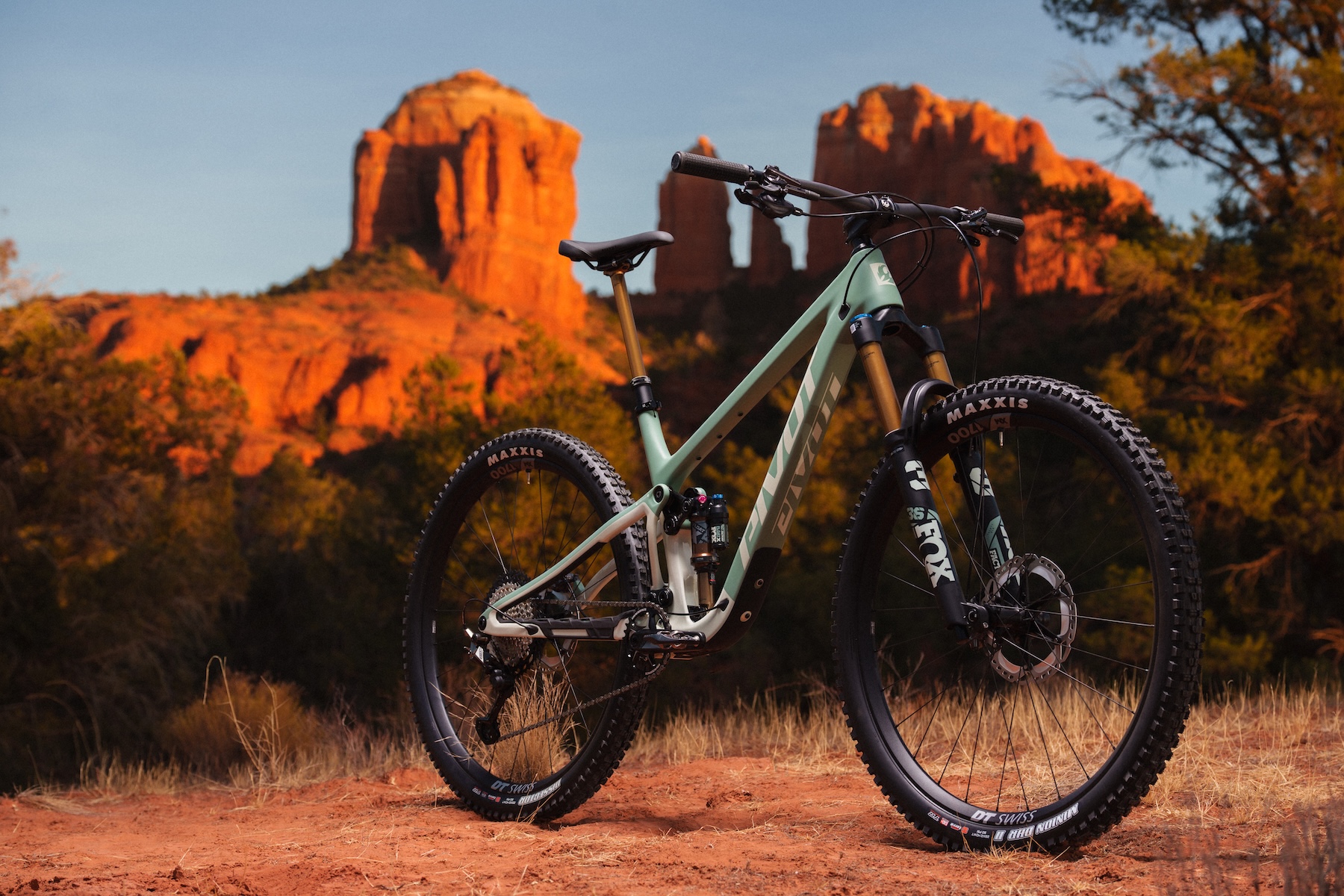
Highlights from each available model’s builds are as follows:
- Drivetrain: Shimano SLX M7100 / XT M8100
- Brakes: Shimano SLX M7120 4-piston (203 mm front / 180 mm rear rotors)
- Fork: Fox 36 Performance Grip (150 mm)
- Shock: Fox Float X Performance
- Wheels: DT Swiss M1900
- Dropper Post: SDG Tellis (XS: 105-125 mm, S: 130-150, M: 150-170 mm), E13 Vario (L–XL: 180-210 mm)
- Drivetrain: SRAM GX Eagle Transmission
- Brakes: SRAM DB8 4-piston (180 mm rotors)
- Fork: Fox 36 Performance Grip (150 mm)
- Shock: Fox Float X Performance
- Wheels: DT Swiss M1900
- Dropper Post: SDG Tellis (XS: 105-125 mm, S: 130-150, M: 150-170 mm), E13 Vario (L–XL: 180-210 mm)
- Drivetrain: Shimano XT M8100 / XTR M9100
- Brakes: Shimano XT M8120 4-piston (203 mm front / 180 mm rear rotors)
- Fork: Fox 36 Factory Grip X2 (150 mm)
- Shock: Fox Float X Factory
- Wheels: DT Swiss XM1700
- Dropper Post: Fox Transfer Factory (XS: 95-120 mm, S: 125-150, M: 155-180 mm, L–XL: 185-210 mm)
Optional wheel upgrade to Reynolds Blacklabel 329 Trail Pro rims with Industry Nine Hydra hubs (+$1,200 USD)
Optional suspension upgrade to Fox Float X Live Valve Neo and Fox Transfer Neo seatpost (+$2,000)
- Drivetrain: SRAM XO Eagle Transmission
- Brakes: SRAM Maven Silver 4-piston (180 mm rotors)
- Fork: Fox 36 Factory Grip X2 (150 mm)
- Shock: Fox Float X Factory
- Wheels: DT Swiss XM1700
- Dropper Post: Fox Transfer Factory (XS: 95-120 mm, S: 125-150, M: 155-180 mm, L–XL: 185-210 mm)
Optional wheel upgrade to Reynolds Blacklabel 329 Trail Pro rims with Industry Nine Hydra hubs (+$1,200 USD)
Optional suspension upgrade to Fox Float X Live Valve Neo and Fox Transfer Neo seatpost (+$2,000)
- Drivetrain: Shimano XTR M9100
- Brakes: Shimano XTR M9120 4-piston (203 mm front / 180 mm rear rotors)
- Fork: Fox 36 Factory Grip X2 (150 mm)
- Shock: Fox Float X Factory
- Wheels: Reynolds Blacklabel 329 Trail Pro rims w/ Industry Nine Hydra hubs
- Dropper Post: Fox Transfer Factory (XS: 95-120 mm, S: 125-150, M: 155-180 mm, L–XL: 185-210 mm)
Optional suspension upgrade to Fox Float X Live Valve Neo and Fox Transfer Neo seatpost (+$2,000)
- Drivetrain: SRAM XX Eagle Transmission
- Brakes: SRAM Maven Ultimate 4-piston (180 mm rotors)
- Fork: Fox 36 Factory Grip X2 (150 mm)
- Shock: Fox Float X Factory
- Wheels: Reynolds Blacklabel 329 Trail Pro rims w/ Industry Nine Hydra hubs
- Dropper Post: RockShox Reverb AXS (XS: 100 mm, S: 125, M–L: 150 mm, XL: 170 mm)
Optional suspension upgrade to Fox Float X Live Valve Neo and Fox Transfer Neo seatpost (+$2,000)
FULL REVIEW
Shorter-travel Trail bikes have undergone a bit of a renaissance in the past couple of years, getting big gains in descending poise while keeping an efficient, snappy feel. The Trailcat SL and Trailcat LT are Pivot’s latest stab in that shorter travel segment, relying on a shared frame with different lower shock mounts and shock lengths to generate 120 mm and 135 mm of travel, respectively.
We’ve been riding the Trailcat LT for a few months now and logged some time on the Trailcat SL to experience the range of the Trailcat family. Despite many obvious similarities, their on-trail performance was more differentiated than expected, and while both should have broad appeal, they’re not without their quirks.
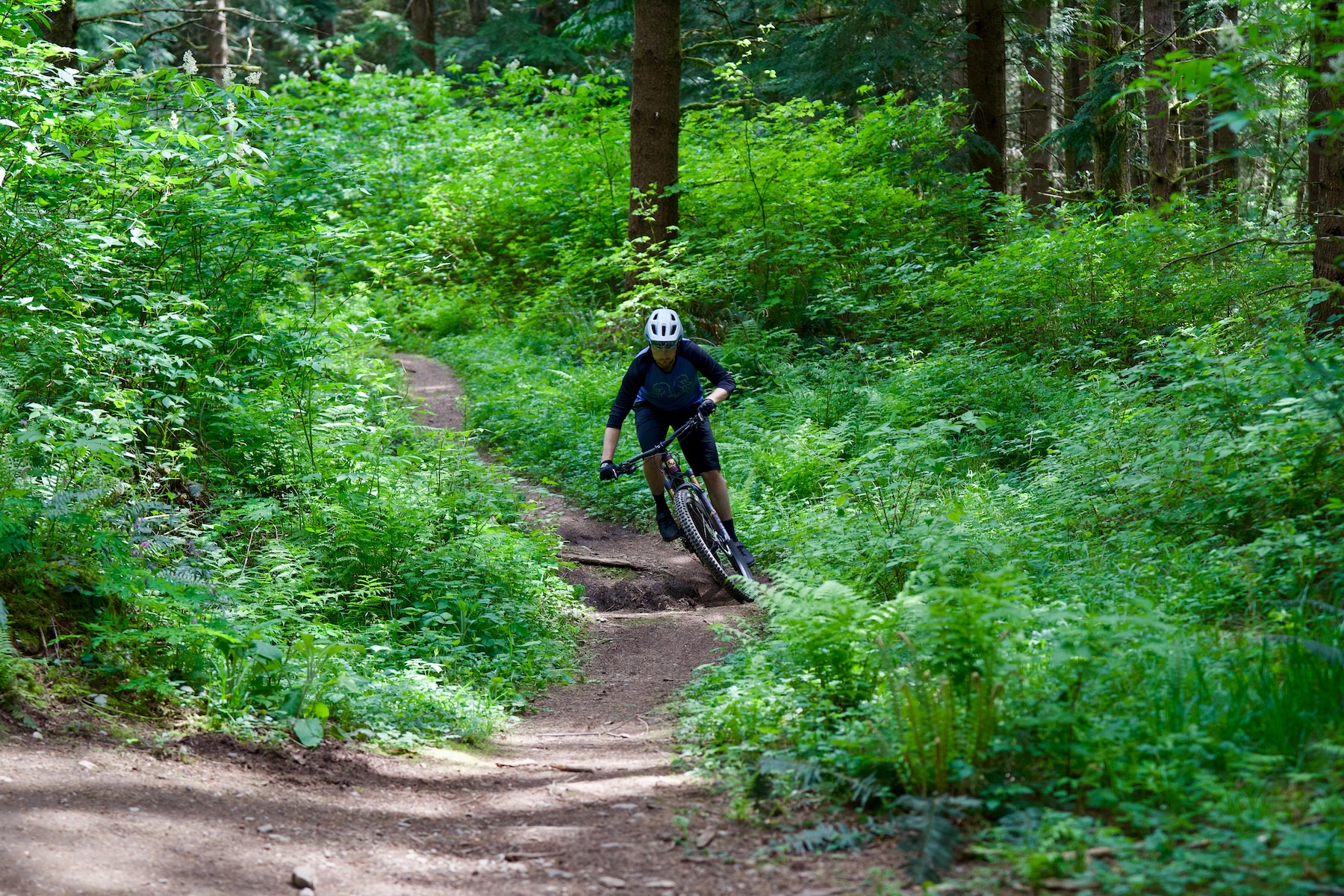
Fit & Sizing
Trailcat LT
I will lead with the Trailcat LT, given that it’s the model I spent the most time with. I talked at length about my initial struggles with the Trailcat LT’s sizing in my Flash Review, but the short of it is that while the size Large is still definitely the right size for me, I struggled initially with the slack-ish 75.6° effective seat tube angle, which created a rather long seated cockpit and rearward weight bias. Paired with the 200 mm dropper that I ended up preferring, I think that the effective seat tube angle felt even slacker than advertised, though Pivot says that the effective seat tube angle is calculated based on the average saddle height for riders of a given frame size. That slacker seat tube angle means that effective top tube measurement rings in at 648 mm, which is, for reference, a full 20 mm longer than a Large Trek Fuel EX. While there are solutions to compacting the cockpit a bit, such as running a shorter stem, more spacers under the stem, etc., the real pickle here was that I also didn’t want the standing cockpit to feel that much shorter than it did with its 475 mm reach.
My first move was to swap the stock 45 mm stem for a shorter 31 mm one that I had sitting around, and to slide the seat as far forward as the rails would allow. This yielded a more comfortable seated position, but the 31 mm stem wasn’t working for me — I generally don’t like ultra short stems for their effects on handling, and with the Trailcat LT’s 65.3° head tube angle already delivering quick steering, the stem swap made things feel overly nervous while also exaggerating the rearward weight bias by creating a more upright riding position. The short stem had the effect of shortening the standing cockpit feel, too, so I ended up backing off to a less aggressive 40 mm stem and found the handling to feel a lot more neutral and in line with my preferences.
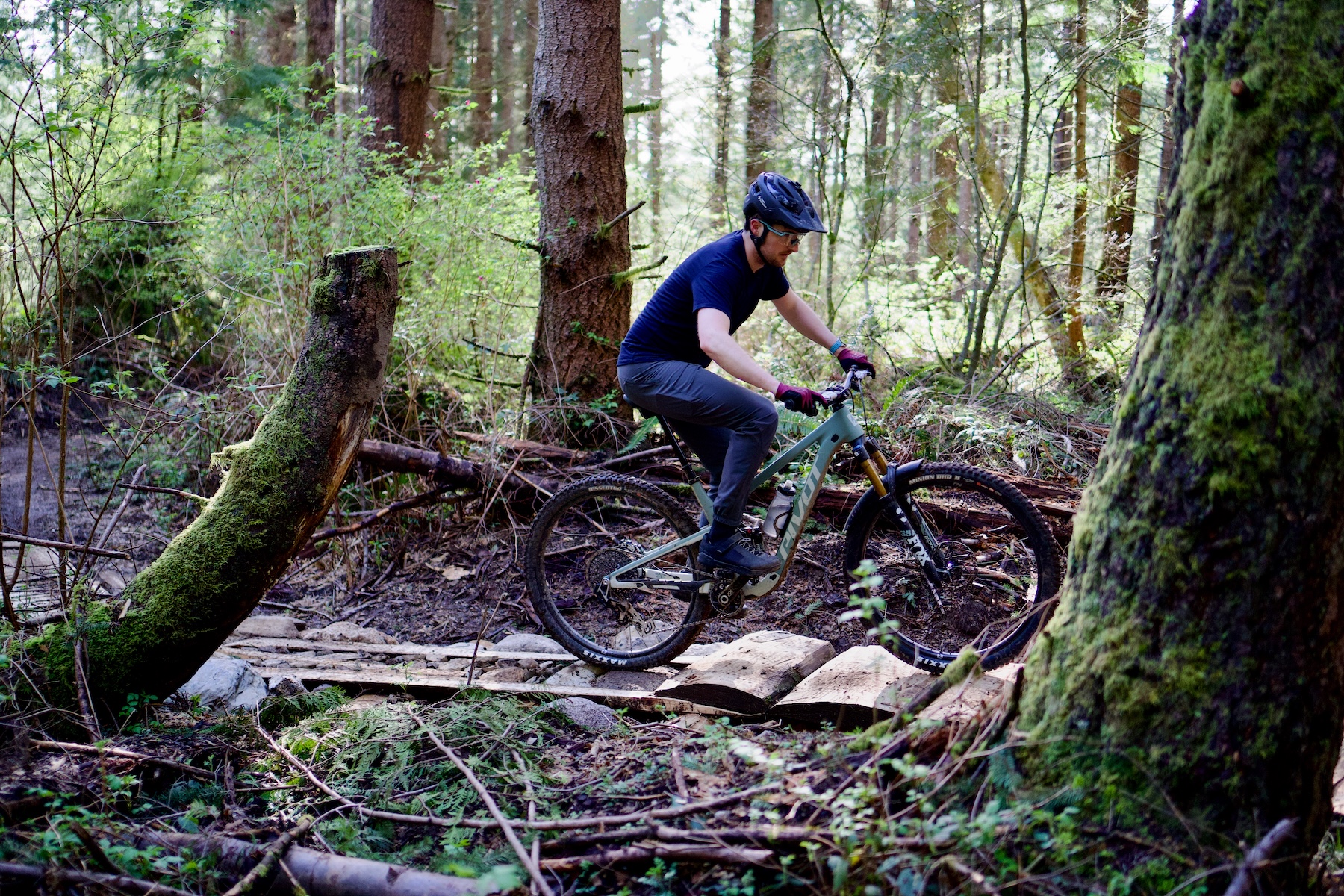
With those changes made (and a swap to a 30 mm rise handlebar), I had found my preferred setup for the Trailcat LT. Even with those changes, though, I still wish the Trailcat LT had a slightly steeper seat tube angle that dialed back the effective top tube length while bringing my weight further forward. While I could swap from the Low to the High setting for a steeper 76° seat tube angle and improved seated position, the steeper 65.6° head tube angle felt overly nervous for the bike’s intentions.
Trailcat SL
The Trailcat SL’s geometry doesn’t deviate much from the Trailcat LT’s on paper, but the small differences add up to a more natural-feeling body position, at least for my preferences in a shorter-travel Trail bike. In the same low position that I used almost exclusively with the Trailcat LT, the Trailcat SL’s effective seat tube angle is a bit steeper at 76°, as is the head tube angle at 65.8°. The reach on our Large is also a bit longer than the equivalent Trailcat LT’s at 480 mm, but the steeper seat tube helps to shorten the seated fit.
While the effective top tube length is only 2 mm shorter than the Trailcat LT’s on paper at 646 mm on a Large, the Trailcat SL’s comparatively steeper seat tube angle means that higher saddle positions don’t elongate the effective top tube measurement quite as much as they do on the LT. Consequently, I didn’t struggle as much with getting my weight distribution right, and while I did place the stem a bit higher on the steerer tube to get more height out of the front end, the longer reach figure on the Trailcat SL also bought me a bit more wiggle room to do that compared to the LT without shortening the standing position too much.
It’s also worth mentioning that I’m generally a bit more comfortable with a stretched-out seated position on a short travel bike like the Trailcat SL, which feels XC-adjacent in its intentions. The steeper head tube angle and steeper seat tube angle combination seem to better distribute my weight over the chassis, and the overall fit just felt a little more natural than it did with the Trailcat LT.
Climbing
Trailcat LT
DW-Link suspension is usually (but not always) tuned to provide good pedaling efficiency, and that was absolutely the case with the Trailcat LT. Paired with the lightweight tire spec and sporty-feeling Reynolds Blacklabel 329 Trail Pro wheels, the Trailcat LT encourages high-output climbing. The rear suspension holds up well under pedaling forces but still feels fairly soft off the top, and the Trailcat LT is both comfortable and quick on more technical climbs. I’ll get into this a bit later, but it feels like Pivot has selected a fairly light compression tune for the rear shock, but given how supportive the DW-Link rear suspension feels under pedaling forces, I think it works well for balancing forgiveness and efficiency.
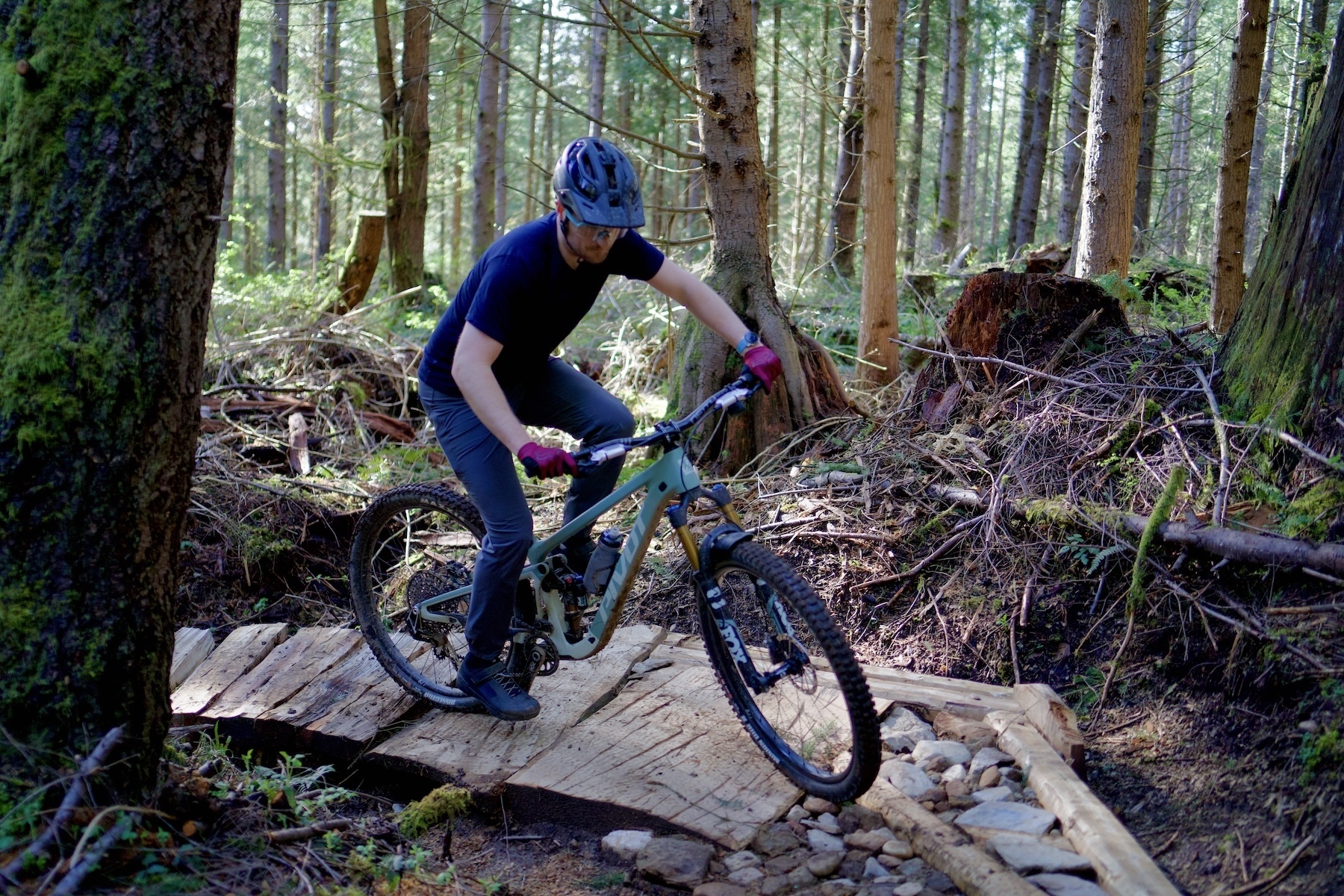
As much as I enjoyed a more spirited pace aboard the Trailcat LT, truly tight and technical bits of trail could feel a little bit more awkward than I expected. While sliding the saddle forward helped to shorten the seated cockpit, I still felt like the short 433 mm chainstays felt a bit out of balance with the rather long seated fit, resulting in a rearward weight bias that could feel at odds with the short chainstays and long front end. This was most noticeable when making more dramatic changes in direction, such as in tight switchbacks, where it could feel like the bike preferred to pivot off of the rear wheel rather than be more aggressively steered through the turn with your weight up over the front. The Dissector rear tire prioritizes rolling speed over grip, and I found that when I tried to get my weight up over the front on really steep sections, it tended to lose traction. With shorter travel, sporty bikes in this category, I typically apply a more aggressive approach to leaning forward and driving the front wheel around switchbacks, but the Trailcat LT requires a more delicate touch in low-traction situations. As I hinted earlier, swapping to the High flip chip position did make a meaningful positive impact on climbing performance, but with downsides for its descending poise due to the steeper head tube angle and higher bottom bracket.
On flatter and more rolling terrain, those small complaints about the weight balance while climbing fade away. The Trailcat LT feels fleet-footed and maintains momentum well, while the rather poppy-feeling suspension makes it easy to unweight over obstacles in the trail without losing much speed. The 65.3° head tube angle affords some very quick handling, making quick direction changes easy and even encouraged, hinting at the Trailcat LT’s playful dynamic that starts to materialize on the way down the hill.
Trailcat SL
As hinted in the fit section above, the Trailcat SL’s geometry generally worked a bit better for my body positioning preferences on this sort of bike, and the Trailcat SL felt like a more intuitive climber than the Trailcat LT as a result. The slightly steeper seat tube angle helped to push my weight a bit more centrally between the wheels, while the steeper 65.8° head tube angle felt very quick to change direction. The Trailcat SL feels very much like it has just 120 mm of rear travel on the way up, and it retained all of the good things about the rear suspension feel of the Trailcat LT while feeling even more taut and responsive.
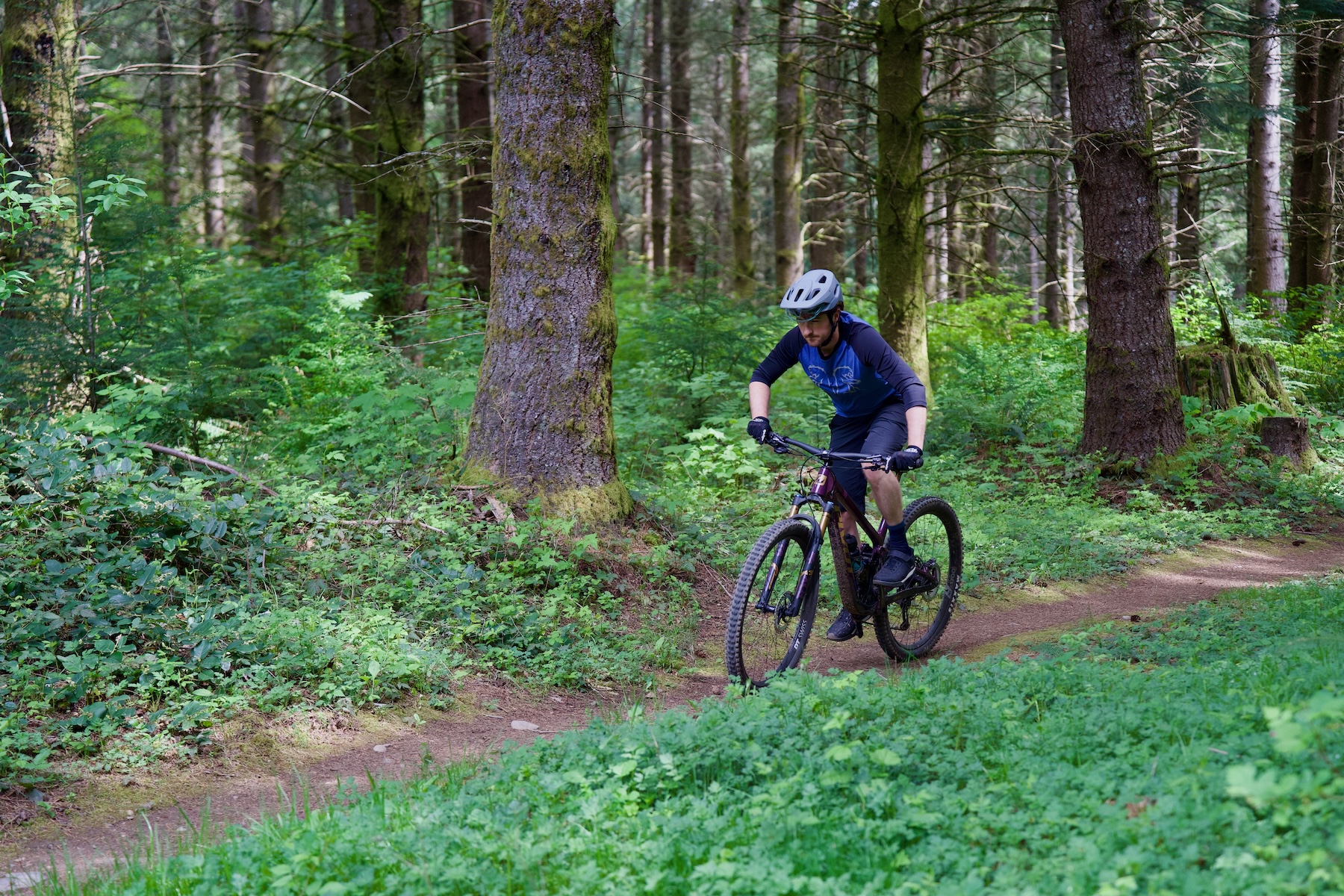
The shorter 120 mm of rear travel and energetic feel of the Fox Float shock encouraged riding the Trailcat SL more like some racier XC bikes, and the steering felt a little more intuitive. I think the slightly lower amount of sag and slightly steeper seat tube angle help to keep my center of mass a bit more naturally forward on the bike, and I felt like I was able to drive through tight corners more effectively than I could on the Trailcat LT. Where the Trailcat LT often forced me to let off the gas a bit and focus on my body position while navigating switchbacks, the Trailcat SL required fewer corrections and allowed me to keep delivering power to the rear wheel.
Descending
Trailcat LT
Pointing the Trailcat LT down the hill is a fun and engaging experience. The wheelbase isn’t that long, thanks to the short chainstays and steep-ish head tube angle, and the very sporty suspension has a lot of life to it. The result is a markedly playful interpretation of a modern Trail bike that still has enough grip and forgiveness to mask mistakes.
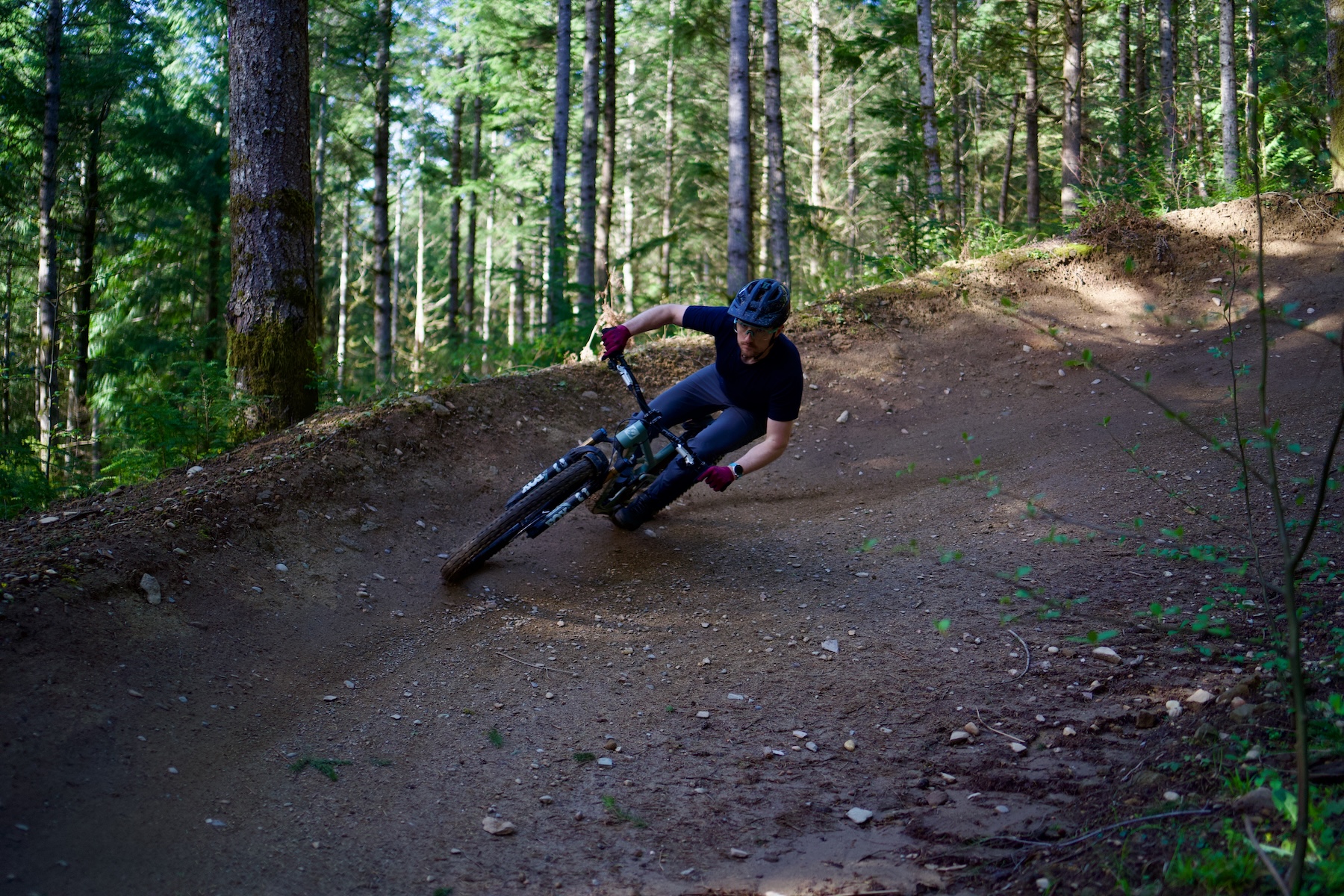
The Trailcat LT’s handling is decidedly on the quicker side of things, aided by the laterally stiff frame and lightweight carbon wheels. While the reach is still fairly average for a size Large at 475 mm, the Trailcat LT does feel rather light and compact in its handling, encouraging a very playful riding style. Small obstacles start to look a whole lot like jumps, and trail gaps are easily cleared thanks to the responsive suspension. The sharp handling of the Trailcat LT encourages lots of direction changes to seek out the most fun and interesting obstacles on the trail, and it takes flight with ease on proper jump trails, easily conquering more technical jump lines where precision is key. It also managed to forgive overshot jumps and poor line choices where traction was at a premium, largely thanks to the supple rear suspension and rather supportive Fox 36 Grip X2.
The flipside is that the Trailcat LT does not feel all that composed as speeds pick up on rougher trails. While the sharp steering can feel fun and engaging at higher speeds when trails are smoother, the Trailcat LT can get knocked around a bit on genuinely technical trails. The 433 mm chainstays help the Trailcat LT feel very playful on trails with well-supported corners and jumps, but come with a tradeoff in the form of stability, and the 65.3° head tube angle doesn’t help much there either. While there are examples of bikes in this travel bracket that are very poised on rough trails (looking at you, Forbidden Druid V2), I would place the Trailcat LT on the other end of the spectrum — it feels very engaging on flatter trails, but gives up some composure when things get burly.
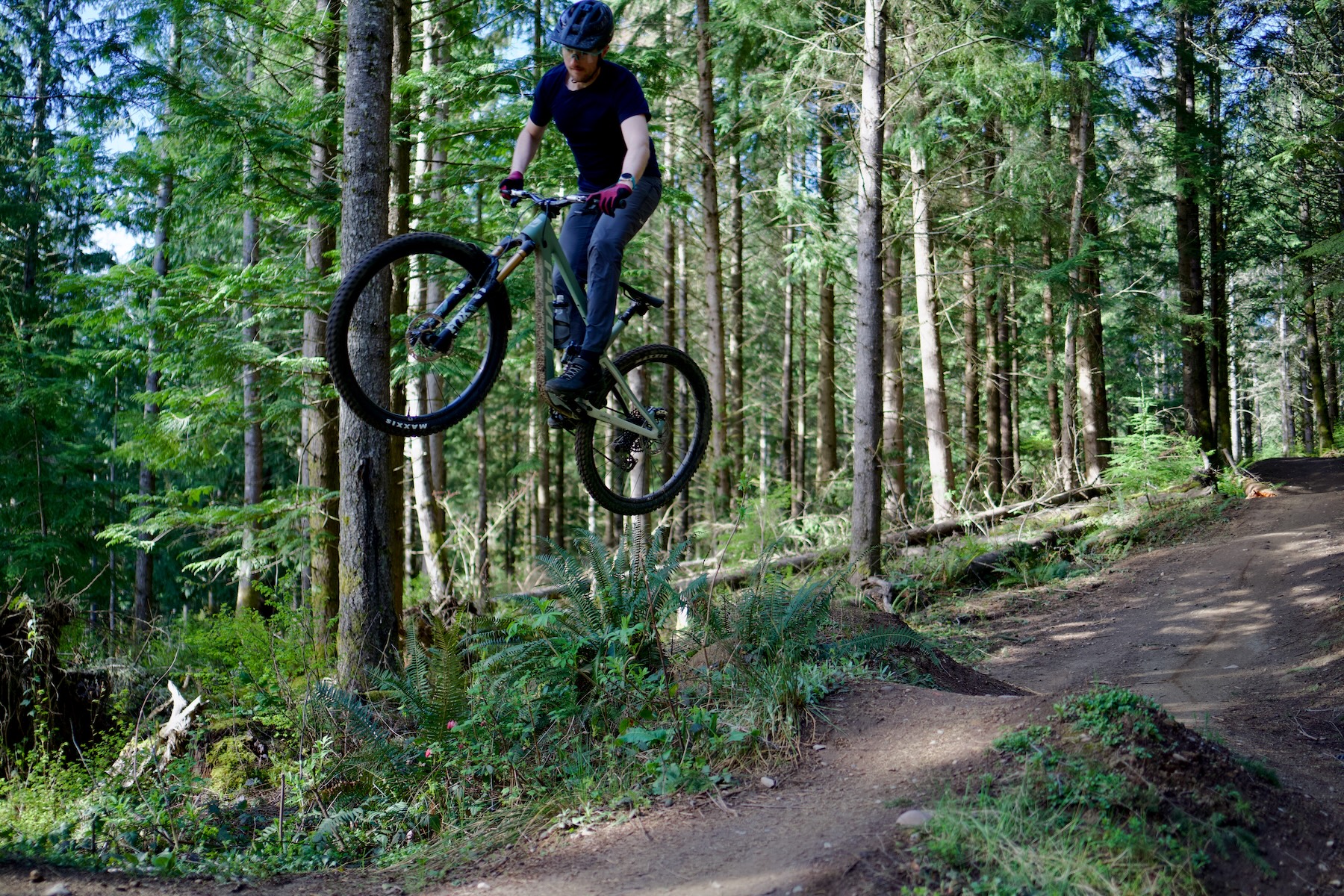
Another aspect of the Trailcat LT that might play into its less planted feel is the fairly light-feeling tune on the rear shock. I typically run my rebound settings close to fully open on a lot of stock tunes, but I was right in the middle of the range on the Float X, while also running a good bit of low-speed compression. I found that I also needed to run a bit more than recommended pressure to get the support I wanted in the middle of the travel, which usually points to the stock compression tune being a bit light. While the light tune seemed to give the Trailcat LT some of its plush yet springy and playful personality, I do think that a slightly firmer tune might help things feel a bit more composed through high-speed hits.
Trailcat SL
Where the Trailcat SL was the more natural-feeling climber compared to the Trailcat LT, it starts to show its limits a bit sooner on the way down the hill. But for riders who like a lively and engaging ride that can bring some additional spice to their regular trails, the Trailcat SL delivers.
In flatter, more rolling terrain, the Trailcat SL does a great job of holding onto momentum and feeling easy to loft over obstacles. The SL’s rear suspension ramps up more quickly than the Trailcat LT’s, encouraging a very active riding style and jumping over obstacles to retain momentum. Smoother descents with small rollers and jumps were a lot of fun on the Trailcat SL, and it felt lighter on the trail than its 30.16 lbs / 13.68 kg weight might otherwise suggest. The quick turning encourages precise line choices, too, which can unlock new lines, and the suspension delivers the pop needed to boost off of smaller jumps while still providing enough sensitivity to hold things together on harsher landings.
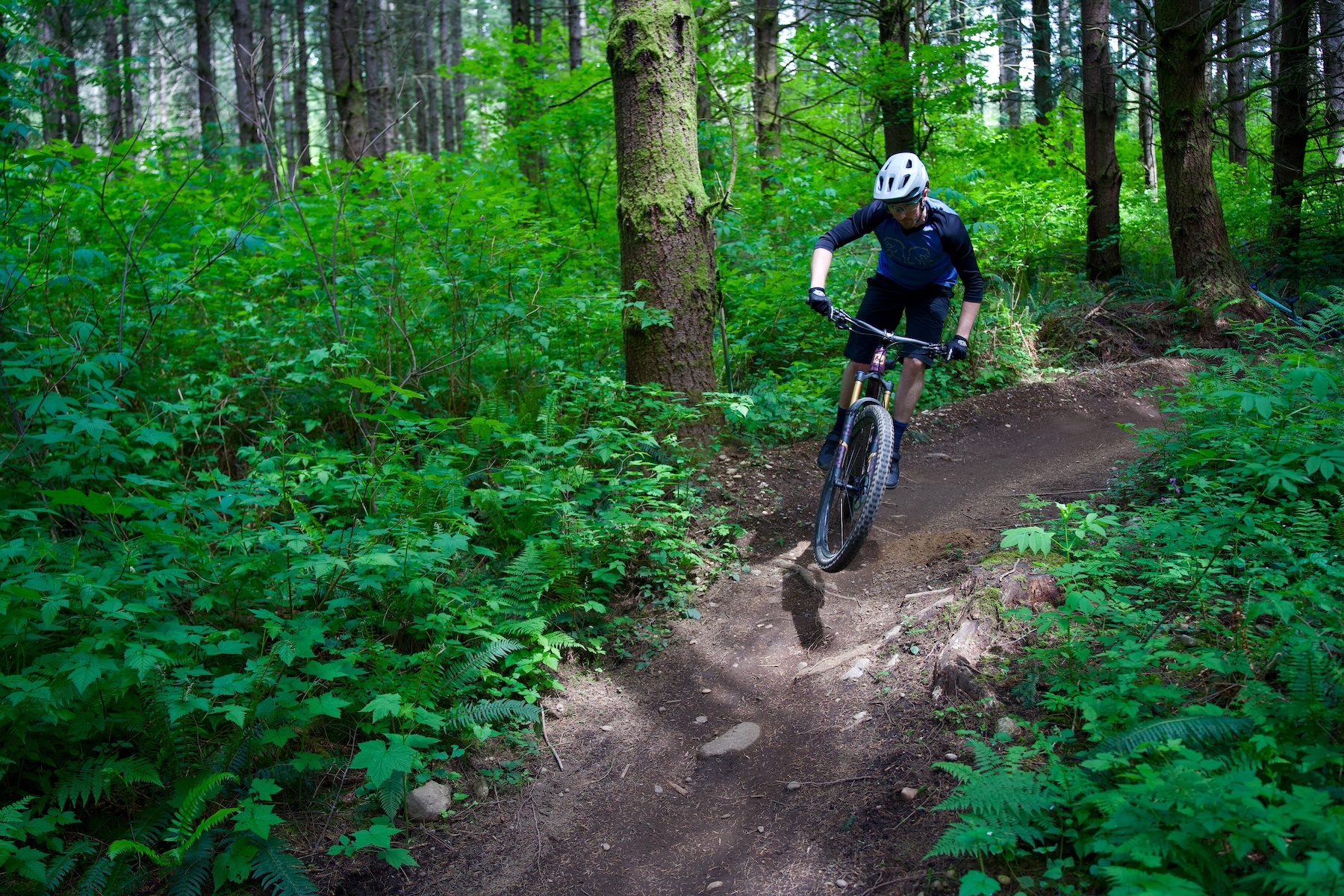
On steeper and faster trails, the Trailcat SL is still a load of fun when you can hit your lines just right, but can’t hang on for as long as its longer-travel sibling when things get rough. The head tube angle is on the steeper side of things, perhaps not for a bike with 120 mm of rear travel, but definitely for something with 140 mm of travel up front. As a result, while the impressive Fox 34 Grip X2 fork does its best to keep the chassis composed, it can take a bit of work to keep the Trailcat SL pointed in the right direction as speeds get particularly high. The Fox 34 isn’t as stiff as the 36 on the Trailcat LT, so it doesn’t track quite as well at the front wheel, but I think the lighter Fox 34 is still the right spec choice. Rather than having fork envy, I found myself often wishing for the slightly slacker head tube angle of the Trailcat LT, and I actually think that a 0.5° slacker front end would bring far more benefits to the Trailcat SL’s descending performance than it would downsides to its climbing manners.
The Builds
Trailcat LT
Our Trailcat LT Team XX build costs an eye-watering $11,299 USD, and for that price, it had better have a dialed build. Fortunately, it did for the most part, with a couple of small issues.
The first and most significant one (which may be remedied if Pivot updates the spec to include the new RockShox Reverb AXS dropper) is the limited drop of the prior generation Reverb AXS post. As I mentioned earlier, I swapped the stock 150 mm travel unit for a 200 mm dropper, but in my mind, the Large deserves at least a 170 mm travel version. The Trailcat LT rewards an active riding style, and that’s hard to do with a 150 mm dropper limiting your range of motion.
The Fox 36 Grip X2 fork was a treat, and it paired well with the Trailcat LT’s personality. The latest Grip X2 damper offers quite a bit of compression support if desired, which is in part what highlighted the light tune of the Float X rear shock — I would prefer a slightly firmer shock tune, but that’s a fairly personal preference.
The SRAM Maven brakes were a surprise given their brutal power, but I actually really enjoyed them on the Trailcat LT even if they felt a bit overkill — I’ll take more braking power over less any day, especially on a stock build. They did reveal the limitations of the Dissector rear tire when it came to braking traction, and I’d even consider downsizing the rear rotor to 160 mm if this were my personal bike, or even bumping up to a DHR II rear tire for more braking bite. I wouldn’t be surprised if Pivot made the switch to the new (and very good) Motive brakes from SRAM, which would drop a good bit of weight over the Mavens and offer a significantly lighter lever feel, which remains my only hang-up with the Mavens.
Trailcat SL
The Pro XT/XTR build on our Trailcat SL test bike still comes at a considerable price at $7,499 USD, but it’s substantially cheaper than the Team XX build that was on our Trailcat LT (the Team XX build costs $11,099 USD for the SL). Despite the very significant cost savings, I found the Shimano-supplied shifting and braking performance of the Trailcat SL to leave little to be desired. While the aluminum DT Swiss wheels did give up some of the responsiveness of the Reynolds Blacklabel 329 Trail Pro wheels found on the Trailcat LT we tested, they were very comfortable and performed very well overall. Frankly, I think the combination of parts on the Pro XT/XTR build presents the most compelling value proposition of all the builds on offer.
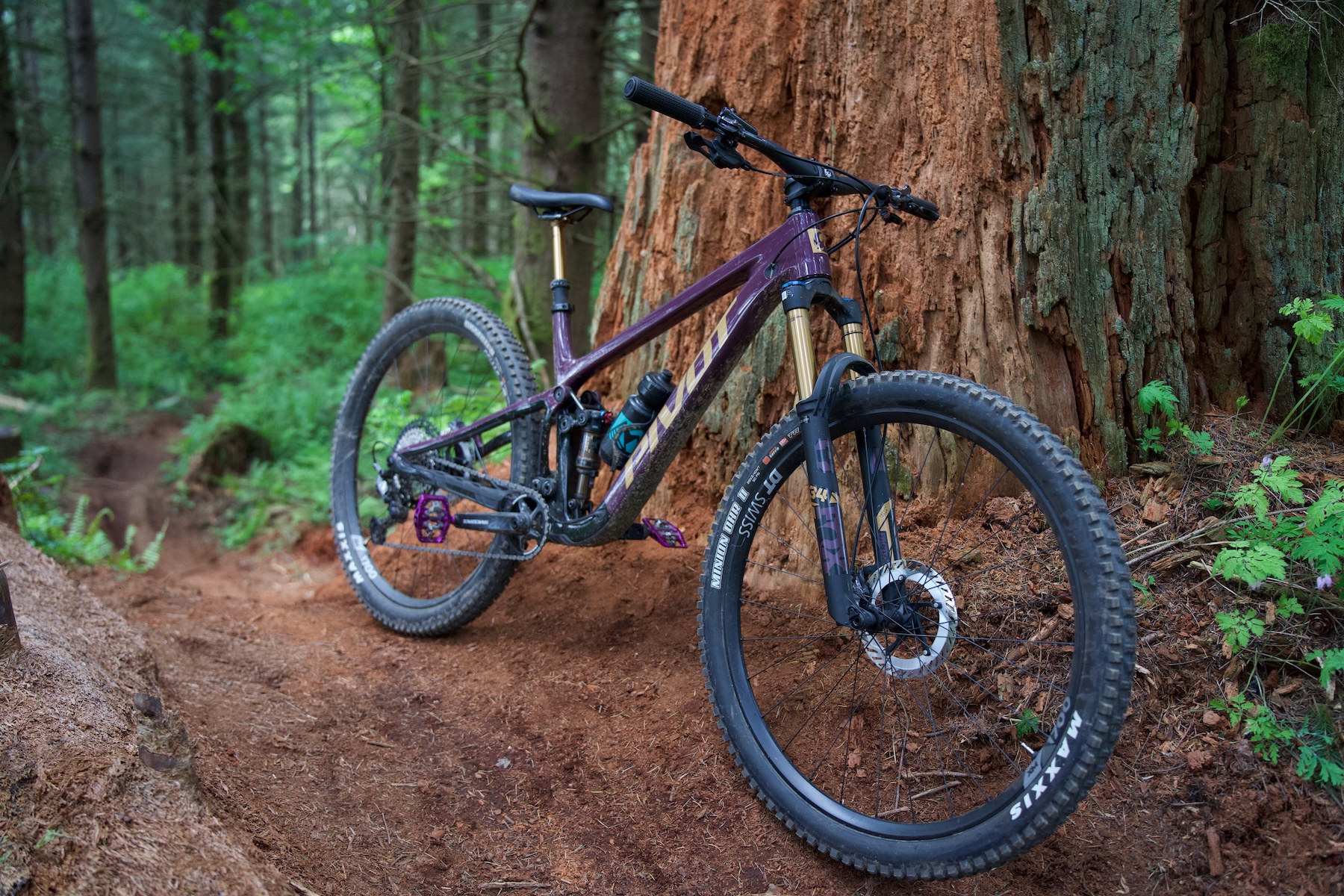
The 140 mm travel Fox 34 feels very well matched to the Trailcat SL, and it’s quite a luxury to have a damper as good as the Grip X2 packaged in such a lightweight fork. The 140 mm Fox 34 Grip X2 has been replaced by the Fox 36 SL in Fox’s recent shuffling of their fork lineup, and while the improvements in stiffness claimed by the 36 SL sound enticing, I found the skinnier 34 to feel well matched to the Trailcat SL’s fleet-footed feel.
While the Trailcat SL’s Fox Float rear shock still feels like it has a fairly light damper tune, I didn’t notice the downsides quite as much as I did on the slightly longer travel Trailcat LT. I generally found that I wasn’t as tempted to push the Trailcat SL hard on rough descents, which went some way toward reducing my demands from the rear shock — and there’s less travel that needs to be controlled. I was pretty happy with the Float shock as a result, and didn’t feel like I was missing much relative to something like a Float X for the Trailcat SL’s intended use.
Who’s It For?
The Trailcat LT and SL both cater to efficiency-minded riders in the very broad Trail category, but their relatively modest differences in travel and geometry create fairly different bikes. The Trailcat LT keeps things comfortable and quick for longer rides, but brings enough forgiveness to be a lot of fun as speeds pick up, particularly on trails with lots of jumps and supported corners. The fit took some getting used to and never felt quite dialed for my preferences and proportions, mostly while climbing, but its efficiency was addictive when I wanted to push the pace.
The Trailcat SL took that need for speed up a notch on climbs and in more rolling terrain. It inspires and rewards high-output riding, but it’s not quite as demanding as a lot of true XC bikes when you just want to get out for a fun, playful cruise. It is a more intuitive climber thanks to a better weight distribution for my particular proportions, but it loses its cool more quickly on descents compared to its longer-travel sibling. For my local after-work laps, it was the bike I was more excited to reach for when I wanted to cover a lot of ground quickly and add some spice to familiar trails.
So, where does that leave us? For riders who value versatility and a touch more confidence in technical terrain, the Trailcat LT is the better choice. The Trailcat SL, though, will appeal to riders who are almost contemplating an XC bike, but want a little bit more comfort and forgiveness at the expense of some weight.
Bottom Line
The Trailcat LT and SL prove that there’s quite a bit of range that can be brought out of a shared frame. By relying on different shock mounts and shock lengths, Pivot has created two bikes that should serve as compelling options for Trail riders who like an efficient, sporty ride. Neither one pushes the boundaries of descending performance as far as other bikes in the category, but they also have much more responsive steering and pedaling performance, and that’s a whole lot of fun in the right terrain.
Share this post:

I’m well over 500 miles on my personal Trailcat LT and have some thoughts about the bike as well, some of which are similar to the ones in the article and some of which are different. As a background of other similar bikes I’ve ridden recently, in my current bike fleet I have a Trail 429 Enduro and a SB140 in addition to the Trailcat LT and have spent some time pedaling around a few other trailbikes such as the Delano Peak
It is my opinion that this bike is very well designed for the type of trails that I ride in southern US, particularly including Texas, which are dry, rocky, and punchy. All of my daily rides are essentially rolling hills with rocky features strewn throughout the trails. I’ve also ridden this bike on the US east coast in trail systems such as Dupont and Bent Creek in North Carolina, which while it has some chunky sections, it is not unrelenting chunk like Pisgah proper (where other bikes beat out this bike)
Speaking to the headtube angle, I really enjoy the slightly steeper headtube angle on my local trails where I am weaving in and out of trees and cutting around (and/or often going over) large rocks. I ride my size large with a slightly longer stem than the bike came with (50mm on all of my bikes) and I find that it puts an appropriate amount of weight onto the front wheels.
I do agree that the seatube is slightly slack, but I’m of the opinion that a bike that sees a lot of rolling hills mileage is better without a very steep seat tube. On my LT, I don’t have my seat all the way forward and overall find the pedaling position to be more comfortable and stretched out than on my sb140 and sb160 (which also echoes the sentiment from the discussion on the podcast about the long front end of the trailcats). I’m sure if I was doing more of a winch-and-plummet ride like I do on an enduro bike worthy ride, I’d have more qualms with the seat tube angle, but to me, that feels outside what this bike was designed to do.
As for the chainstays, I’ve ultimately settled on the fact that I do like the current length and for my trails, where all-out descending speed only comes in bursts and tight turns are most of the turns. I like having a bike with shorter chainstays compared to my sb140 and can feel the difference as the bike whips around the trees that hug the trails here
I also think that of the DW link bikes I’ve ridden, this is one of my favorites in regards to how the suspension platform performs. It feels significantly more like a hoverbike while pedaling over roots and rocks. It pedals well, so much so that it remains my bike of choice on my weekly XC group rides (trading some plushness for some pedaling efficiency) and still holds up to any of the rougher and more technical trails around my local trail network.
All that said, I think your last line sums this bike up well “responsive steering and pedaling performance, and that’s a whole lot of fun in the right terrain.” Having ridden this bike in a lot of varied terrain now (Across a few US states), this bike really comes into its own in the rolling hills with punchy features.
Thanks for the detailed rundown of your experience, and glad you’re getting along so well with your Trailcat LT! I very much agree that it’s a bike that performs well when changing direction, whether that’s in the chunky terrain of the Southwest or on some of the more technical trails in my local area of the Northwest. The suspension is very good, and I agree with the balance of efficiency and forgiveness that you characterized.
Re: the seat tube length, I typically agree with you on a slightly slacker seat tube angle being a better choice on a bike of the Trailcat LT’s intentions, while steeper ones cater best to Enduro bikes. For my inseam length, I think my saddle height paired with the the slacker than average seat tube put my weight just a bit further back than I would like while significantly elongating the seated cockpit, leading to my fit issues. If my inseam were slightly shorter, it’s entirely possible that I would have found the position to be just fine, and I would have liked to run a longer stem as you do for handling reasons as mated to the steeper head tube. I should also note that a lot of our climbs here in the Northwest are quite steep, and I found that my challenges with the fit were more exaggerated as the trail’s incline steepened.
I agree with your thoughts on the chainstays, too – on more technical and tight trails, they helped with quick direction changes despite the lengthy front end. My point was more to highlight that, relative to some comparable bikes with similar intentions, the short stays do give up a bit of all out stability when pushing the bike beyond its use case.
Thanks for the reply, Zack! Always like listening to what you have to say on the podcast.
It seems like we are in agreement about the bike’s best and worst attributes.
It sounds like our bike fit is different as well. I’m 6ft tall, but I don’t have a particularly long inseam for my height and usually my pedaling position ends up being a touch lower than my buddies who are the same height. Seemingly, my torso is longer instead, so I tolerate a slightly longer front center quite well. While my bike has seen some steep climbs when I’ve ridden it out in NC, I often find myself on other bikes when the trails get very steep (both up and down).
Understood about the chainstays, I agree on that as well! When speeds pick up, I find a bike like the sb140 more stable than the trailcat LT and I sometimes do wonder how I would like the LT if it had longer chainstays.
These sound like the typical darn near perfect Pivot for me. Shame about the superboost rear spacing.